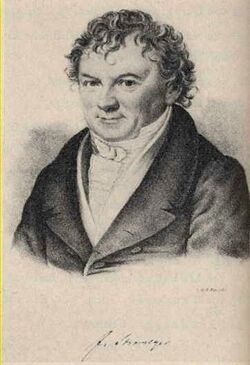فريدرش شتروماير
Friedrich Stromeyer | |
|---|---|
 Friedrich Stromeyer | |
| وُلِدَ | 2 أغسطس 1776 |
| توفي | 18 أغسطس 1835 (aged 59) Göttingen, Kingdom of Hanover |
| الجنسية | German |
| المدرسة الأم | University of Göttingen |
| اللقب | discovering Cadmium |
| السيرة العلمية | |
| المجالات | Chemist |
| الهيئات | University of Göttingen |
| المشرف على الدكتوراه | Johann Friedrich Gmelin Louis Nicolas Vauquelin |
| طلاب الدكتوراه | Robert Bunsen Eilhard Mitscherlich |
| أثـّر على | Leopold Gmelin |
Prof Friedrich Stromeyer FRS(For) FRSE (2 August 1776 – 18 August 1835) was a German chemist. He was the discoverer of cadmium.
From 1982 a Friedrich Stromeyer Prize has been awarded for chemical achievement in Germany.[1]
. . . . . . . . . . . . . . . . . . . . . . . . . . . . . . . . . . . . . . . . . . . . . . . . . . . . . . . . . . . . . . . . . . . . . . . . . . . . . . . . . . . . . . . . . . . . . . . . . . . . . . . . . . . . . . . . . . . . . . . . . . . . . . . . . . . . . . . . . . . . . . . . . . . . . . . . . . . . . . . . . . . . . . . .
الحياة
He was born in Göttingen on 2 August 1776[2] the eldest son of Dr Ernerst Johann Friedrich Stromeyer, professor of medicine at Göttingen University, and his wife, Marie Magdalena Johanne von Blum.[3]
Stromeyer studied Chemistry and Medicine at Göttingen and Paris and received an MD degree from the University of Göttingen in 1800, studying under Johann Friedrich Gmelin and Louis Nicolas Vauquelin. He was then a professor at the university, and also served as an inspector of apothecaries. His students included Robert Bunsen.[4]
In 1817, whilst studying compounds of zinc carbonate, Stromeyer discovered the element cadmium. Cadmium is a common impurity of zinc compounds, though often found only in minute quantities. He was also the first to recommend starch as a reagent for free iodine and he studied chemistry of arsine and bismuthate salts.
In 1819 he was the first scientist to describe the mineral eudialyte.[5]
In 1826 he was elected a Fellow of the Royal Society of Edinburgh his proposer being Edward Turner. As his fellowship was Ordinary (rather than Foreign or Honorary) this means he was physically present in Edinburgh at that time. The following year he was elected a Foreign Fellow of the Royal Society of London.[6]
In 1832 the mineral stromeyerite was named in his honour by mineralogist François Sulpice Beudant.[7]
He died in Göttingen on 18 August 1835 aged 59.[8]
المراجع
- Lockemann, Georg; Oesper, Ralph E. Friedrich Stromeyer and the history of chemical laboratory instruction, J. Chem. Educ. 1953, 30, pp. 202–204.
- I. Asimov, Asimov's Biographical Encyclopedia of Science and Technology (2nd Ed.), Doubleday, 1982, pp. 276–277.
- M.E. Weeks, Discovery of the Elements (7th Ed.), Leicester, H. M., Ed., J. Chem. Educ., 1968, pp. 502–508.
- J. R. Partington, A History of Chemistry, Macmillan, 1962, vol. 3, pp. 659–660.
- Biographisches Lexikon der hervorragenden Ärzte, Urban & Schwarzenberg, 1962, vol. 5, p. 566.
- ^ Gesellschaft Deutscher Chemiker – Inhaber des Friedrich-Stromeyer-Preises
- ^ Biographical Index of Former Fellows of the Royal Society of Edinburgh 1783–2002 (PDF). The Royal Society of Edinburgh. July 2006. ISBN 0-902-198-84-X. Archived from the original (PDF) on 2016-03-04. Retrieved 2018-10-03.
- ^ Gero von Wilcke: „Der Chemiker Friedrich Stromeyer, Vorfahren und Seitenverwandte“. In: „Archiv für Sippenforschung“, 33./34.Jg. 1969, S. 130–134.
- ^ "Friedrich Stromeyer - the Mathematics Genealogy Project".
- ^ Rare Earths Industry: Technological, Economic, and Environmental Implications edited by Ismar Borges De Lima, Walter Leal Filho
- ^ Biographical Index of Former Fellows of the Royal Society of Edinburgh 1783–2002 (PDF). The Royal Society of Edinburgh. July 2006. ISBN 0-902-198-84-X. Archived from the original (PDF) on 2016-03-04. Retrieved 2018-10-03.
- ^ Stromeyerite Mindat.org
- ^ "Friedrich Stromeyer".